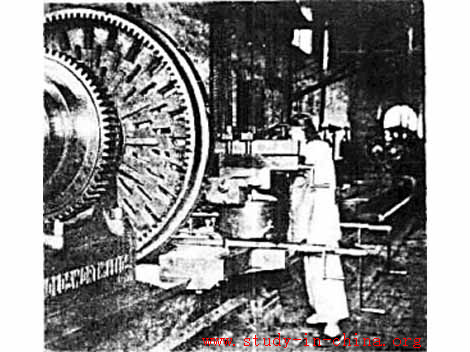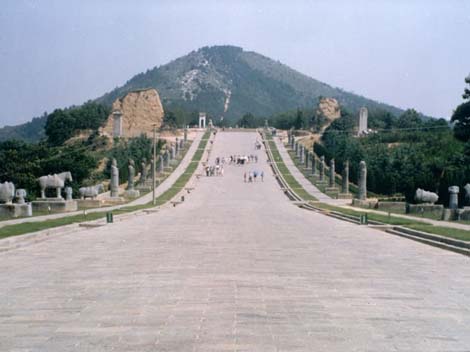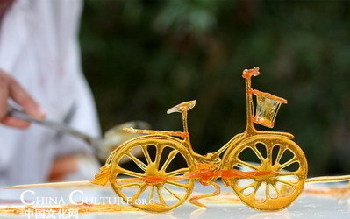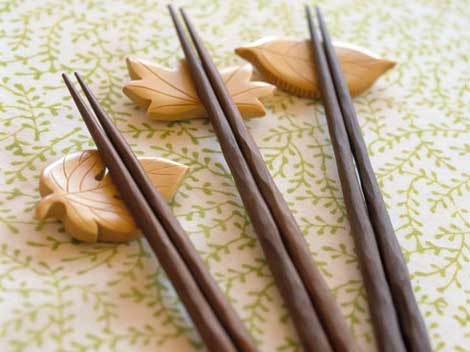| Home > China Feature |
The Westernization Movement

The rude realities of the Opium War, the unequal treaties, and the mid-century mass uprisings caused Qing courtiers and officials to recognize the need to strengthen China. Chinese scholars and officials had been examining and translating "Western Learning" since the 1840s. Under the direction of modem-thinking Han officials, Western science and languages were studied, special schools were opened in the larger cities, and arsenals, factories, and shipyards were established according to Western models. Western diplomatic practices were adopted by the Qing, and students were sent abroad by the government and on individual or community initiative in the hope that national regeneration could be achieved through the application of Western practical methods.
Amid these activities came an attempt to arrest the dynastic decline by restoring the traditional order. The effort was known as the Tongzhi Restoration, named for the Tongzhi Emperor (1862-1874), and was engineered by the young emperor's mother, the Empress Dowager Ci Xi (1835-1908). The restoration, however, which applied "practical knowledge", while reaffirming the old mentality, was not a genuine program of modernization.
The effort to graft Western technology onto Chinese institutions became known as the Self-Strengthening Movement. The movement was championed by scholar-generals like Li Hongzhang (1823-1901) and Zuo Zong-tang (1812-1885), who had fought with the government forces in the Taiping Rebellion. From 1861 to 1894, leaders such as these, now turned scholar-administrators, were responsible for establishing modem institutions, developing basic industries, communications, and transportation, and modernizing the military. But despite its leaders' accomplishments, the Self-Strengthening Movement did not recognize the significance of the political institutions and social theories that had fostered Western advances and innovations. This weakness led to the movement's failure. Modernization during this period would have been difficult under the best of circum-stances. The bureaucracy was still deeply influenced by Neo-Confucian orthodoxy. Chinese society was still reeling from the ravages of the Taiping and other rebellions, and foreign encroachments continued to threaten the integrity of China.
The first step in the foreign powers' effort to carve up the empire was taken by Russia, which had been expanding into Central Asia. By the 1850s, tsarist troops also had invaded the Heilong Jiang watershed of Manchuria, from which their countrymen had been ejected under the Treaty of Nerchinsk. The Russians used the superior knowledge of China they had acquired through their century-long residence in Beijing to further their aggrandizement, in 1860 Russian diplomats secured the secession of all of Manchuria north of the Heilong Jiang and east of the Wusuli Jiang (Ussuri River). Foreign encroachments increased after 1860 by means of a series of treaties imposed on China on one pretext or another. The foreign strangle-hold on the vital sectors of the Chinese economy was reinforced through a lengthening list of concessions. Foreign settlements in the treaty ports became extraterritorial---sovereign pockets of territories over which China had no jurisdiction. The safety of these foreign settlements was ensured by the menacing presence of warships and gunboats.
At this time the foreign powers also took over the peripheral states that had acknowledged Chinese suzerainty and given tribute to the emperor. France colonized Cochin China, as southern Vietnam was then called, and by 1864 established a protectorate over Cambodia. Following a victorious war against China in 1884-1885, France also took Annam. Britain gained control over Burma. Russia penetrated into Chinese Turkestan (the modern-day Xinjiang-Uyghur Autonomous Region). Japan, having emerged from its century-and-a-half-long seclusion and having gone through its own modernization movement, defeated China In the war of 1894-1895. The Treaty of Shimonoseki forced China to cede Taiwan and the Penghu Islands to Japan, pay a huge indemnity, permit the establishment of Japanese Indus-tries In four treaty ports, and recognize Japanese hegemony over Korea. In 1898 the British acquired a ninety-nine-year lease over the so-called New Territories of Kowloon (or Jiulong in pinyin), which Increased the size of their Hong Kong colony. Britain, Japan, Russia, Germany, France, and Belgium each gained spheres of influence in China. The United States, which had not acquired any territorial cession, proposed in 1899 that there be an "open door" policy in China, whereby all foreign countries would have equal duties and privileges In all treaty ports within and outside the various spheres of influence. All but Russia agreed to the United States overture.
Art
 more
moreYicheng Hua Gu
The Flower Drum 花鼓 of southern Shanxi Province is a kind of folk d...

Sculpture in Qianling Mausoleum
The sculpture of Qianling Mausoleum is the main relic of the ground ...

A Sweet Art:Sugar Painting
In and around China’s southwestern Sichuan Province, it is usual to ...

Custom
 more
moreWeb Dictionary
Martial Arts
Wuxia, a Popular Culture for Most Chinese-Speaki...
Wuxia (武侠) is a broad genre of Chinese fiction that concerns its...
“Chinese Kung Fu Hot”
“Part the Wild Horse’s Maneton Both Sides”, “White Crane Spreads Its...
“Chinese Kung Fu Hot” in Alfred University
“Part the Wild Horse’s Maneton Both Sides”, “White Crane Spreads Its...





 print
print  email
email  Favorite
Favorite  Transtlate
Transtlate 







